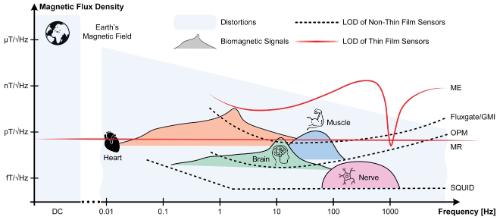Thin-Film Magnetoelectric Composite for pico-Tesla Magnetomyography
Supervisors: Dr Hadi Heidari and Professor Sandy Cochran
Measurements of electrical activity from the skeletal muscles, Electromyography (EMG), is very well-established in today’s medical diagnosis [1,2]. Magnetomyography (MMG) provides more accurate spatial localisation of muscle movement activities than EMG, a complementary method of recording brain activity. Clearly, EMG has the distinct disadvantage of being invasive. Despite these obvious advantages of corresponding magnetic measurements, the high cost and cumbersome traditional MMG sensors (e.g. SQUID: superconducting quantum interference device) block the spread of such magnetic diagnostic techniques. The magnitude of the EMG signal is in the scale of milli-volts while the MMG signal is in the scale of pico (10−12) to femto (10−15) Tesla (T), decreasing strongly with the distance between the sensor and the muscle fibre (Figure 1). However, the main advantages of non-invasive MMG measurements with magnetometers are vector information, a long-term biocompatibility with tissue, a higher signal-to-noise, and better positioning and fast screening of sensors without electrical contacts, where the magnetic sensors can be fully packaged within a biocompatible material.

Figure 1. Comparison of magnetic signals produced by various sources of the human body, with limits of detection of several sensor types.
Developing highly sensitive magnetic sensors to measure weak biomagnetic signals in the sub-pico-Tesla level requires excellent accurate device modelling and simulation that can comprehensively predict device fabrication malfunctions. This PhD project focuses on device modelling of magnetoelectric (ME) thin-film composites comprising magnetostrictive and piezoelectric materials. The research involves the physical design and implementation of a Metglas/PZT based ME sensor in a finite element method (FEM) model using COMSOL Multiphysics®. The parameters of the model are extracted from the state-of-the-art fabrication and experimental data in the lab. The high-sensitivity of ME sensors with a linear response of an external magnetic field will provide a reliable benchmark for the future development of hybrid CMOS systems in the biomagnetic measurements. The design will be validated for the detection of biomagnetic signals from muscle, MMG, where the field strengths in the pico-Tesla range can be measured.
Reference
[1] Heidari, H. (2018) Magnetoelectronics: Electronic skins with a global attraction. Nature Electronics, 1(11), pp. 578-579.(doi:10.1038/s41928-018-0165-2)
[2] Zuo, S., Nazarpour, K. and Heidari, H. (2018) Device modelling of MgO-barrier tunnelling magnetoresistors for hybrid spintronic-CMOS.IEEE Electron Device Letters, 39(11), pp. 1784-1787. (doi:10.1109/LED.2018.2870731)

